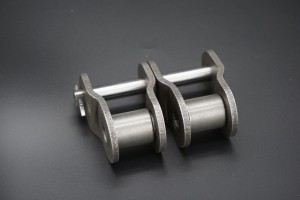Roller chains are key components in many industrial and mechanical applications, providing a reliable method of transmitting power from one rotating shaft to another. They are commonly used on a variety of machinery, including conveyors, agricultural equipment, motorcycles and bicycles. The strength of a roller chain is a key consideration in its design and selection as it directly affects the chain’s ability to withstand the forces and loads encountered during operation.
So, how strong is a roller chain? The strength of a roller chain is determined by a variety of factors, including the materials used in its construction, the design of its components, and the manufacturing process employed. Let’s delve into these factors to understand roller chain strength in more detail.
Material selection and performance
The strength of a roller chain is greatly affected by the materials from which it is constructed. High-quality roller chains are typically made from alloy steel for excellent strength, durability, and wear resistance. The specific alloy composition and heat treatment process used in the manufacturing process play an important role in determining the ultimate strength of the chain.
Alloy steel chains are often heat treated to improve their mechanical properties such as tensile strength, hardness and toughness. Through carburizing, quenching and other processes, the surface hardness of the chain can be improved, thereby improving the wear resistance and fatigue resistance. Additionally, the core of the chain can be reinforced to ensure it can withstand high impact loads without deforming or breaking.
Design and Engineering
The design of a roller chain is critical in determining its strength and performance. The size and geometry of chain components, including inner and outer plates, pins, rollers and bushings, are carefully designed to ensure optimal strength and load-bearing capacity.
Pitch, or the distance between adjacent pin centers, is a key design parameter that affects chain strength. A smaller pitch generally results in a stronger chain because it allows for more points of contact between the chain and sprockets, distributing loads more evenly and reducing stress concentrations.
Additionally, the shape and contours of the chain components have been carefully designed to minimize stress concentrations and increase fatigue resistance. The smooth rounded profile helps distribute loads more evenly and reduces the potential for stress concentrations that can lead to premature failure.
manufacturing process
The manufacturing process used to produce a roller chain also plays a vital role in determining its strength. Precision manufacturing techniques such as cold forming and precision machining are used to ensure dimensional accuracy and consistency of chain components.
In addition, quality control measures are implemented, including rigorous testing and inspection procedures to verify the strength and integrity of the finished chain. Tensile testing, hardness testing and metallographic analysis are often used to evaluate the mechanical properties of chains and ensure they meet specified strength requirements.
Factors affecting roller chain strength
Several factors affect the strength of a roller chain, including the type of load it is subjected to, operating conditions and maintenance practices employed. Understanding these factors is critical to selecting the correct chain for a given application and ensuring its long-term performance.
Loading conditions
The type and magnitude of load applied to a roller chain has a direct impact on its strength requirements. Chains used in high-torque applications, such as industrial drive systems, must be able to withstand significant tensile forces without stretching or breaking. Likewise, the chains used in conveyor systems must be able to support the weight of the material being conveyed without excessive wear or fatigue.
Operating conditions
The environment in which a roller chain is used also affects its strength and durability. Factors such as temperature, humidity, exposure to chemicals or corrosives, and the presence of abrasive contaminants can all affect chain performance. For example, chains used in outdoor applications may require additional corrosion protection, while chains used in high-temperature environments may require heat-resistant lubricants and materials.
maintenance practices
Proper maintenance is critical to maintaining the strength and service life of your roller chain. Regular lubrication helps reduce friction and wear, while regular inspections can catch potential problems before they cause chain failure. Additionally, maintaining proper chain tension and alignment prevents premature wear and fatigue, ensuring it performs its full function.
In summary, the strength of a roller chain is the result of careful selection of materials, careful design and engineering, precise manufacturing processes, and consideration of operating conditions and maintenance practices. By understanding these factors, engineers and equipment operators can select the most appropriate roller chain for their specific application, ensuring reliable and robust performance.
Post time: May-24-2024

